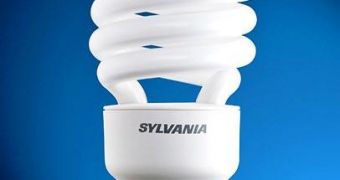The fluorescent light bulbs, also called energy saving light bulbs, give out the same amount of light as the ordinary, incandescent applications, but with many advantages in terms of energy consumption and greenhouse gas reductions.
However, there is one major problem with these lamps, the fact that they contain mercury. Mercury vapor is excited in argon or neon gas by electricity passing through it, thus producing light. So, even if they do save a lot of energy and reduce pollution, the fact that many people dispose of burnt out fluorescent light bulbs in ordinary garbage disposal units can lead to an extremely poisonous mercury contamination.
"They're very efficient, but once they're used up they become a ticking toxic time bomb," said Leonard Robinson, chief deputy director of the California Department of Toxic Substances Control. "They need to be captured and recycled."
Recycling them is the biggest headache caused by these lights, since there are few viable options for gathering and reusing the toxic mercury inside them. The total amount of mercury is even considered negligible by many, who don't take into account the fact that even if one such bulb alone is not dangerous by itself, when numbers add up they produce dangerous quantities of mercury.
"Though they're energy-saving, cost-saving, [they] do contain small amounts of mercury, and for that reason, [they] need a little bit more attention in their disposal," said Joe Bergstein, a spokesman for the EPA's New York City regional office.
"Some counties are better budgeted to do these kinds of collections and handle these kinds of materials on a much more regular basis than others." Even the 5 milligrams of mercury contained by one light bulb can be damaging for the organism if inhaled or absorbed through the skin.
Since each county has to pay a company to handle the collection and recycling of these bulbs and citizens are not always willing to take a trip to their friendly neighborhood fluorescent light bulbs recycling company, lots of them get dumped into the trash.
"More and more states are starting to ban throwing CFLs away, but on a whole, probably more of these are making it into the trash than are being recycled," said Robinson, the California official. "The two reasons they'll toss them: they either don't know or they don't care. If we can educate the ones who don't know, we can pressure the ones who don't care."

 14 DAY TRIAL //
14 DAY TRIAL //